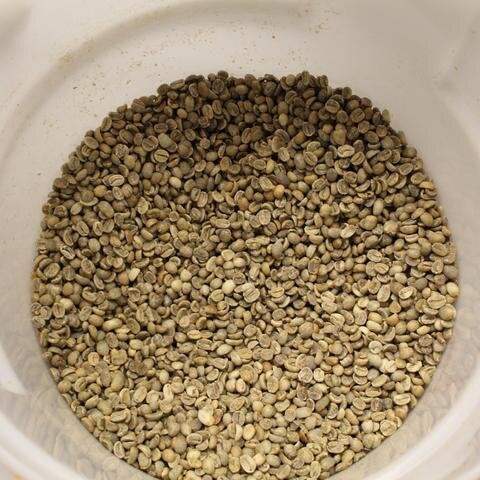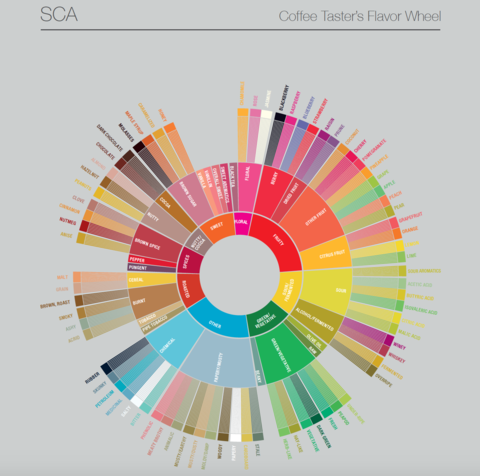The simplest way to define an excellent cup of coffee is a cup of coffee that tastes excellent. In our last few blog posts, we have shown that excellent coffee does not just fall out of the sky; it requires painstaking effort from farm to cup. But how do roasters like Baba Java know that we are importing excellent coffee before it has even arrived? The process of sample roasting (receiving small, usually 200g, green samples of harvests) always culminates in a process called cupping, a long-used practice explored in this blog.
Coffee cupping in its simplest form, is the observation of aromas and the taste of coffee once brewed. It can be done informally by anyone or professionally by “Q-Graders” (people trained to grade the quality of coffee). Dating back to the late 19th Century, cupping has long been used by coffee producers, buyers, and traders alike as a means of judging and evaluating the quality of a coffee. It was revolutionary in the coffee industry as previously coffee was judged on appearance alone. Prior to the advent of cupping, color, shape, and size of the coffee beans would dictate the ‘quality’ and decide the final price. Cupping allowed for coffee farmers who had smaller, but more flavourful, high quality beans to receive a fair and accurate payment for their product. Our Yemen coffee is a perfect example of this; the beans are very small, but extremely dense and flavorful. Thanks to cupping, our farmers receive a fair price for their coffee that in turn helps them develop their communities. If it were not for cupping, it’s possible there would not be any Yemen coffee grown anymore.

Cupping came to prominence in the specialty coffee industry in the late 1990’s when it was used by judges in the prestigious coffee competition “Cup of Excellence.” This competition is held each year in several coffee producing countries to find out whose crop is the best in the country. Each coffee entered is cupped and receives a cupping score. Baba Java’s current Colombian coffee came from a farm in Colombia, Finca El Faldon, that won this competition in 2011. Arnulfo Leguizamo’s lot that year scored a 94.05 cupping score which beat the second place coffee by a point and a half!
Needless to say, after its utilization in the Cup of Excellence competition, the Specialty Coffee Association of America (SCAA) standardized the practice by producing a cupping form and requirements, establishing the industry standard for cupping which remains to this day. These guidelines are designed to ensure only the most accurate of assessments are made when cupping. In the industry, this is of the utmost importance as green coffee must be graded against the system, requiring a score of at least 80 out of 100, in order to be considered specialty coffee. Cupping offers a rubric by which we are able to conduct tests with an assured level of repeatability, with the equipment, degree of roast, and brew ratio all standardized. Having this degree of standardization allows us to compare results by repeating the same tests.
The setup used when conducting a cupping should consist of a table, cupping bowls, cupping spoons and scoring sheets. A cup of hot water to wash off the spoons between each slurp and a towel to dry the spoons need to be on the table is also needed. There are specific measurements and ratios set by the SCAA that should be followed for a professional cupping. These include a ratio of 8.25 grams of whole bean coffee to 150ml water, a cupping vessel between 7-9 fluid ounces, water temperature between 92.2 – 94.4 °C, and a specific grind size. Roasters are at liberty to change these when conducting an informal cupping but must follow the guidelines for it to be an official cupping. It is imperative, however, that the measurements and ratios are recorded to allow for the tests to be repeated accurately.
After your table is set with coffee weighed and ground appropriately, a routine cupping should go as follows. The hot water is added to each cup alongside the cup containing the spoons; this is to bring the spoons to the same temperature as the coffee. Observe the smell of each cup whilst being careful not to disturb it as it steeps, writing down any initial observations of the coffee’s aroma. The coffee will form what’s called the ‘crust,’ which is a layer of proteins and grounds on top of the coffee. After 1-2 minutes, break the crust using the back of one of the preheated spoons. This is an important step in the cupping process as you’ll receive the most potent coffee aroma; it’s the ideal moment to evaluate the aroma. After pushing the crust back with the spoon, gently stir the coffee to make sure all the grounds are covered in water and put your nose over the cup as you do this and observe the aroma. Clean the spoon off and move on to the next sample evaluating the aroma’s as you go along. After this, scoop the crust off and tip into an empty cup.
Allow a little time for cooling then take some coffee into the spoon and slurp strongly to aspirate it over the entire tongue. The slurp is the most iconic part of any cupping. Throw all your manners out the window because a loud and strong slurp is imperative so that all your taste buds are covered evenly. As you taste each sample you’ll be writing down observations along the way of the coffee’s taste, acidity, aftertaste and body. Comparing the different cups as you move around the table. Tasting will be taken in intervals to allow time for the coffee to cool, as it cools it’s common for new flavors that weren’t previously detectable to emerge. Therefore, it is important to cup a coffee when it is both warm and when it has cooled to just above room temperature. The best coffees will have positive characteristics at both ranges of temperature.
There are a vast array of flavors that can be tasted in coffee, a very complex spread with some flavors desirable and some not so desirable. In order to help most accurately describe the flavors present in coffee the SCAA provides a “Coffee Taster’s Flavor Wheel”. Consisting of the following nine major categories there is sweet, floral, fruity, sour/fermented, green/vegetative, roasted, spices, nutty/cocoa and other. These are also broken down into twenty-eight sub-categories and further into seventy-three specific flavors, so you’re assured to get a specific flavor profile. When purchasing a bag of coffee, you might notice the flavor notes listed on the bag. Getting an accurate description of the flavor profile is imperative and this is why cupping is so important.

At Baba Java our goal to source, roast, and serve excellent coffee. No stone is left unturned in pursuit of that mission, and cupping plays a huge role in all three of those goals. Whether it’s cupping two different Ethiopia coffees to decide which one to source or comparing 3 different roasts of Yemen coffee to decide the best way to roast it, cupping is a frequently executed and critical practice is our business. This is why we occasionally invite our customers to be involved in the process like we did this summer with our Peru. We hope to do the same with our newest harvest of China coffee after it arrives later this month. Be on the lookout in the next few weeks for your opportunity to be involved in this important step of our roasting process!

